Malcolm D Enlow Memories (thanks to Don, Jr)
Staff Sergeant Malcolm D Enlow
Malcolm Enlow was born at home in Monterey, Louisiana, the fifth child to Jessie and Ramoth Enlow on Jan. 28, 1920. According to son Don, Malcolm had two birth certificates one for Jan 28, 1920, and one for Feb 28, 1920 which was a leap year. He always said the January one was the correct one. His oldest sister, who was a high school student at the time, was the one who got to name him for two of Shakesphere's Mac Beth characters, Malcolm and another Donoblain, which she liked but changed to Donovan.
Jessie's parents had died of yellow fever when Jessie was only 5 years of age. He was raised by his Dawson Grandparents who were buried way back in the woods of Mississippi. Many years later, the Enlows would spend a few Sundays driving that part of Mississippi looking for Jessie's Papa's old home place. Family was very important to Malcolm's father since his own childhood had been interrupted with death, he planned for a more normal childhood for his children.
Malcolm grew up in the lovely community of Monterey surrounded by his loving siblings, Thelma, Clinton, Melba, Jim and Darwin Enlow. Monterey was a small community with a post office and one small store, 16 miles from the nearest town. The children loved running to the post office for Mama. Mama usually read the in-coming letters aloud. Little 7 year old Malcolm listened carefully as Mama read one of older brother Clinton's letter. The mention of Charles Lindbergh flying from New York to Paris caused something to stir inside of Malcolm. He listened with great interest as Mama read, "He was at Kelly Field, Texas when I was there and made a parachute drop, that's how I happen to remember him." The Lindbergh news was very exciting to little Malcolm. It started him to thinking that he would someday like to fly also.
As a kid, Malcolm and his younger brother and their buddies loved camping. Once during the night on a camping trip they heard a noise, Malcolm fired at the noise, the next morning they found he had shot Papa's best hog.
During 1927 the Mississippi River flooded. The Enlow family was forced to live in the attic of their home for weeks before having to relocate to paternal relatives in the hills of Mississippi until the flood receded. After much clean-up the close family was able to move back into the house. Mama and the girls took care of the house cleanup and Papa and the boys repaired fences and barn doors.

L-R:
Malcolm D. Enlow, Dad - Jessie McCormick Enlow, Mother - Ramoth Cross Enlow, Aunt Stella Lanehart, Uncle - Jessie Lanehart, Brother - Darwin Enlow, Niece - Ethel Girlinghouse (Little girl, born in 1928)
Malcolm was the only male student in his class of less than 20 students. In the class following his, two more of his schoolmates had interesting military records. One Lloyd Love was a pilot for the 17BG 34BS completing 73 missions aboard 12th AAF B-26's and Franklin (Jimmy) Burley was an ace flying Navy Hellcats with the VF18 aboard the USS Intrepid, Jimmy was wingman to the second highest scoring Navy ace Cecil Harris. Lloyd later came home and became student body president of LSU, married the LSU homecoming queen, and settled in nearby Ferriday, LA with a career as a lawyer.
After graduation, Malcolm dicided to go to college. He wanted to be a History Teacher, both of his older sisters were teachers so it was natural that he would follow in their footsteps. His civilian occupation was as stock clerk in his older brother's store/bar in Vidalia, Louisianaa while in high school and before going to college.
Along with his college courses, Malcolm also took flying lessons. Somedays, while walking to take a flying lesson he would swim across the bayou to the airport instead of taking the long way around, via the bridge.
After he earned his private pilot license, he applied to flight training with Canada, but was drafted while waiting on the Canadian paper work to go through. Mr. Enlow was drafted on Jan. 7, 1942 in Camp Beauregard, La. after completing 2 years of college. Single and without dependents at the time, he was drafted between his second and third year of college. Dad had left school to help out his older brother in his small store while his Brother was recovering from injuries.
He applied for flight training with the Army, but failed the eye exam. So he then went to aircraft mechanics school on the P-39 Cobra. While stationed in Fla. with the P-39's he saw a post on the board for aerial gunners. He said it was the same eye exam as before, which he passed with flying colors.
Mr. Enlow's first assignment was at Kesler AAF(processing) in Miss, then down to San Antonio (basic), up to Chicago, (mechanics school) from Chicago he went to Niagara Falls for P-39 school, from there it was down to Tallahassee and there joined a fighter group who were flying the P-39's. He left Tallahassee for Harlingin, TX for gunnery school. He was the top gunner in his class shooting one of the highest scores when using the shotguns for skeet shooting. He almost had to stay in Harlingen and become an instructor but with the mechanic background that made him a natural for the engineer/gunner position.
Don recalls his father talking about while training on the B-26 out of Barksdale, they went on a cross country trip to Monroe, LA as a flight. One of the B-26 aircraft in front of his on takeoff had a run-away prop and crashed with the loss of the entire crew. The pilot was a college friend of Mr. Enlow.
Mr. Enlow arrived in the UK during the time of the second and fatal Ijmuiden, Holland mission, a mission in which all ten attacking B-26 bombers were lost in mid May 1943.
Malcolm D. Enlow Sr. was first assigned to the 322nd Bomb Group, 449 Bomb Squadron. Then later, because the crew he was with had experience, they were moved to the 394th Bomb Group when it arrived in England. Crew members were 1st.Lt George B Beckes,pilot, F/O Jack L Hancock, co-pilot, 1Lt Harry C Huber B/N, S/Sgt Malcolm D Enlow gunner, T/Sgt William Lopatin gunner and S/Sgt C T Drake gunner. The crew had begun flying together at Barksdale and remained a crew through their 73rd mission. Aircraft that Mr. Enlow mentioned to his son were: "Lights Out" ( a picture of Hitler being hit with a boxing glove) 394th,584th BS and the other ship was "We-Dood-It" 449th BS(They had a mission to fly and they did it.)
S/Sgt. Enlow was tail gunner, normally the Engineer/gunner was waist gunner but he was a lot smaller than Clyde Duke the armorer/gunner. The crew was blessed, nothing out of the ordinary happened on their many missions, except for dodging enemy flak and one time when Malcolm had to go out in the bomb bay and detach a stuck bomb. Mr. Enlow never mentioned having a jammed or overheated gun.
According to Don, Mr. Enlow claimed he did shoot down one of the Abbyville Kids (Yellow Nose bandits) ME 109 but never got offical credit.
Most of Mr. Enlows V-mail letters home was asking the where abouts of friends who also were stationed in the UK and seeking information about of his two brothers Jim and Darwin.
Malcolm was ready to come home on their last mission No.73. The bombardier Henry Huber went to the flight surgeon on his return because of his nerves. The surgeon was so surprised with the number of missions and length of duty that he sent the entire crew home. He came back to the States before the 394th moved to France having completed 73 missions. "Later, Dad recieved a letter offering Officer Candidate School if he stayed in the Army, but he was tired and took an assignment to Selman Field, Monroe, Louisiana near his home town for the duration of his enlistment obligation."
Malcolm's best memory of war was flight training as a crew, and all the cross countries trips they made. He also enjoyed staying in touch with Lt. Backes crew and attending 322nd reunions as a crew. He loved the Martin B-26 Marauder very much.
Malcolm's worst memories of war was losing his two barracks mates on D-day due to the mid-air crash. That was a very sad day for him. S/Sgt George J Kyle, Radio/gunner and S/Sgt James M Long, Engineer/gunner were both killed in the crash. They were the closest friends that he lost while overseas. Several of his close friends were transferred from the 322nd BG also. The brotherhood bonds were broken, which was very hard on the boys.
Malcolm was very disappointed having to leave his beloved 322nd BG. But then again, his transfer was a rarity due to the fact that his entire crew with whom he had trained with at Barksdale, and flown the Southern route to the UK were transferred to the 394th. Son Don tells us, "I know Dad trusted Lt. Backes. He trusted from the first hand experience the other crews in his formation. Meeting new inexperienced crews would be hard on any veteran crew."
Malcolm returned home and married Joyce Rogers. The young couple were blessed with two chilren Malcolm D. Enlow Jr born 9/23/1949 and younger sister, Brenda Joyce Enlow Jones born 8/18/1952.
From the mid 50's until 1967, both Malcolm and Joyce worked at Armstrong Tire Company, Natchez, MS, Malcolm in sales, and Joyce as the company PBX operator. They had a 40 minute commute each way each day to and from work. Malcolm missed the chance to become sales manager in 1970, so he made the move to work with another tire company based in Chattanooga, TN. Mom didn't go back to work but enjoyed doing crafts, estate sales, went to college and obtained a degree in horticulture.
Mr. Enlow loved aviation, he and his children always ran outside to see what was flying over the house, visited airports and airshows, built model airplanes together and talked about his great B-26. Don has one of two wooden B-26s he carved just prior to his death. Don says, "I still will bet he carved the wooden airplane out of memory instead of looking at plans and prints."
When Don decided he wanted to learn to fly his Dad discouraged him saying, "It isn't fun when you have to fly when somebody else wants you to, and or you are being shot at."
Malcolm attended two different 322 reunions with Bill, Jack, Henry, and his son Malcolm Jr. "Don" at West Point, and in Bosier City, Louisiana. Don says about the reunions, "I have never met a more honorable group of men as the Marauder men I met at those two conventions".
Don Jr. loved hearing his fathers stories and other WWII generation army stories from his friends and brothers on many a Friday night while football was being heard on the radio. He can not remember a day in his life that his dad didn't mention the B-26, his time in England, or his friendships he made from his experience during the WWII era.
The day prior to my Mr. Enlow's death, Malcolm called an Attorney and fellow WWII vet and dear friend Lloyd Love (mentioned above)to do some leagal work for him on his property settlement.
Malcolm, being a historian loved all the Civil War battlefields in and around Chattanooga. The day he passed away, son Don had driven him through his favorite battle field as he had something new to show Don there. S/Sgt. Malcolm D. Enlow Sr passed away May 1,1993.
The home where Malcolm was born, where Mama made so many good meals to fill it with fragrent smells including homemade candy to send to Clinton, is gone now. It housed so many wonderful family memories and tender moments and gave encouragement to Malcolm to become a national hero. Mama and Papa and Malcolm are all gone too, but not forgotten.
Malcolm's handwritten description of his experience.
Click for larger view:
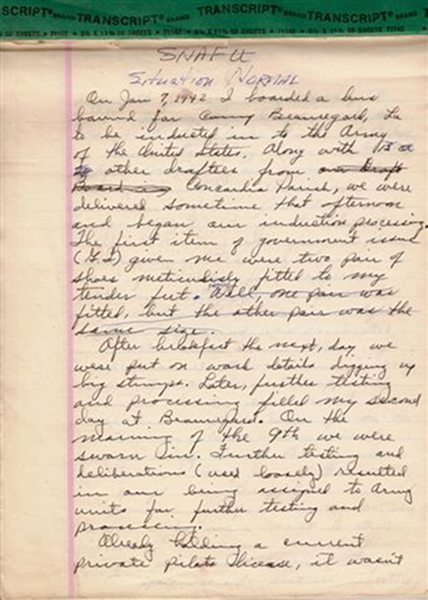
Page 1 | 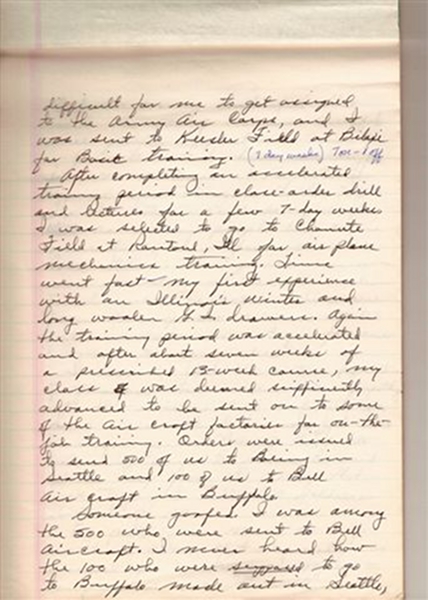
Page 2 | 
Page 3 | 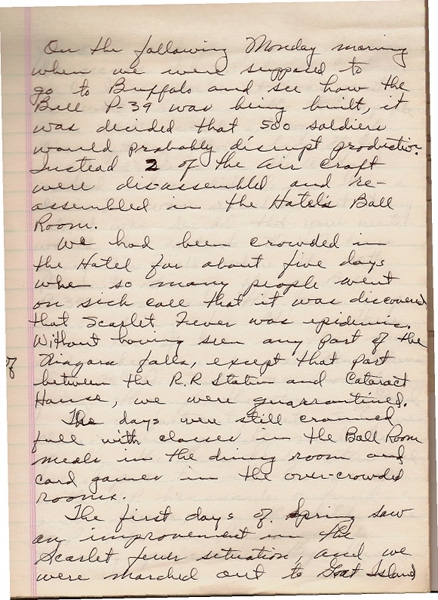
Page 4 | 
Page 5 | 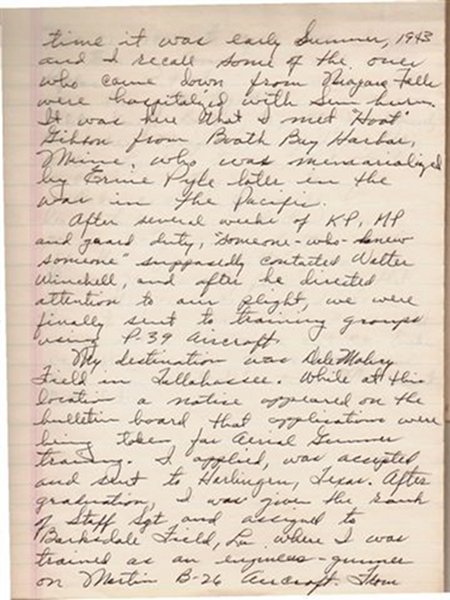
Page 6 | 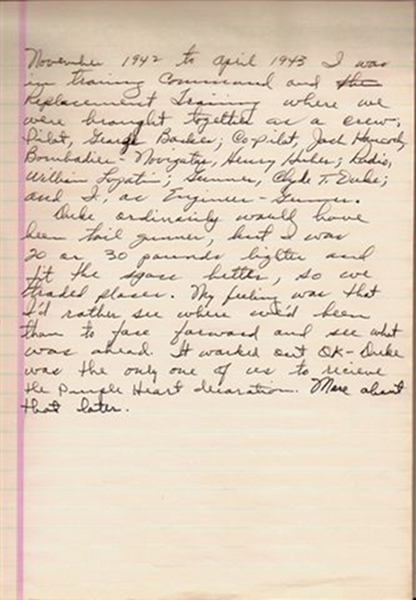
Page 7 |
Transcription:
On Jan. 7, 1942 I boarded a bus bound for Camp Beauregard, LA to be inducted into the Army of the United States. Along with 12 other drafters from Concardia Parish, we were delivered sometime that afternoon and began our induction processing. The first item of govenment issued shoes (GI) given me were two pair of shoes meticulously fitted to my tender feet. Well one pair was fitted, but the other pair was the same size.
After breakfast the next day we were put on work details digging up big stumps. Later, further testing and processing filled my second day at Beauregard. On the morning of the 9th, we were sworn in. Further testing and deliberations (Use loosely) resulted in our being accepted to Army units for further testing and processing.
Already holding a current private pilots license, it wasn't difficult for me to get assigned to the Army Air Corps and I was sent to Keesler Field at Biloxie for basic training. (7 day weeks, 7 on-1 off)
After completing an accelerated training period in close-order drill and lectures for a few 7 day weeks I was selected to go to Channute Field at Rantoul, IL for airplane mechanics training. Time went fast. My first experience with an Illinois winter and long woolen GI drawers. Again the training period was accelerated and after about seven weeks of a prescribed 13 week course, my class was deemed sufficently advanced to be sent on to some of the air craft factories for on-the-job training. Orders were issued to send 500 of us to Boeing in Seattle and 100 of us to Bell Air Craft in Buffalo.
Someome gooted, I was among the 500 who were sent to Bell Air Craft. I never heard how the 100 who were supposed to go to Buffalo made out in Seattle, but the Army contingent that met the 500 of us in Buffalo were quite upset.
Quarters had been arranged for 100 soldiers at the Cataract House in Niagra Falls, N.Y. The old hotel wasn't designed for as many people that came marching up from the rail road station. Some quick decisions were made and all of the civilians guest were evicted while our formation of 500 soldiers waited without barracks bags for our "rooms to be readied".
It seemed that the entire populations of Niagara Falls were in sympathy with the evictees, and naturally so. Some were old ladies who had lived there for years. None of the old guest had any place to move to, and got no help from the Army that was trying to billet 500 soldiers instead of 100.
By putting as many as 8 of us to a room that orginally was designed for a honey-mooning couple, we were "housed".
On the following Monday morning when we were supposed to go to Buffalo and see how the Bell P-39 was being built, it was decided that 500 soldiers would probably disrupt production. Instead, 2 of the air craft were dis-assembled and re-assembled n the hotel's ball room.
We had been crowded in the hotel for about five days when so many people went on sick call that it was discovered that Scarlet Fever was epidemic. Without having seen any part of the Niagra Falls, except that part between the R.R. Station and Cataract House, we were quarantined.
The days were still crammed full with classes in the ball room, meals in the dining room, and card games in the over-crowded rooms.
The first days of spring saw an improvement in the Scarlet Fever situation and we were marched out to Goat Island for our first glimpse of the falls. We never did go to the town and I suppose it was just as well, because the town people were still mad at us for disrupting their life style.
After 3 1/2 years in the Army I never did learn how a decision was reached, but at any rate, it was decided that your writer would be sent to New Orleans Army Air Field where the 20th Pursuit Group flying Bell P-39's was in the process of embarking for China. There were 100 of us in this move and when we reached New Orleans, the 20th Pursuit was probably going through the Panama Canal.
We unfortunate/fortunate 100 (your choice) were quickly made use of by the Base Headquarters an were put to work as guards with M.P. brassards around our sleeve; in the kitchen as KP's: or as prison guards chasing prisioners. By this time it was early summer, 1943 and I recall some of the over who came down from Niagra Falls were hospitalized with sun burns. It was here that I met "Hoot" Gibson from Booth Bay Harbor, Maine, who was memorialized by Ernie Pyle later in the war in the Pacific.
After several weeks of KP, MP and guard duty, "someone-who-knew-someone" supposedly contacted Walter Winchell, and after he directed attention to our plight, we were finally sent to training groups using P-39 aircraft.
My destination was Dale Mabry field in Tallahassee. While at this location a notice appeared on the bulletin board that applications were being taken for aerial gunner training. I applied, was accepted and was sent to Harlingen, Texas. After graduaton, I was given the rank of Staff Sgt and assigned to Barksdale Field, LA where I was trained as as engineer gunner on Martin B-26 Aircraft. From Novmeber 1942 to April 1943 I was in training command and replacement training where we were brought together as a crew. Pilot George Backes; co-pilot Jack Hancock, bombardier-Navigator, Henry Hubes; Radio William Lopatin; Gunner Clyde T. Duke; and I as engineer-gunner.
Duke ordinarily would have been tail gunner, but I was 20 or 30 pounds lighter and fit the space better, so we traded places. My feeling was that I'd rather see where we'd been then to face forward and see what was ahead. It worked out OK - Duke was the only one of us to recieve the Purple Heart decoration. More about that later.













